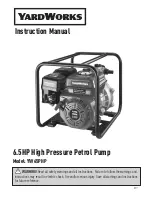
18
We reserve the right to modify technical specifications without prior notice.
83054300dUK
© ait-deutschland GmbH
free running of the systems is achieved with so-called
low-salt operation.
VDI 2035 Part I gives important information and
recommendations regarding scaling and its prevention in
heating and domestic hot water heating systems.
VDI 2035 Part II primarily deals with the requirements
for reducing heating water corrosion in hot water
heating systems.
PRINCIPLES OF PART I AND PART II
The occurrence of scaling and corrosion damage in hot
water heating systems is low, if
- proper planning and commissioning is carried out
- the system is closed in corrosion terms
- adequately dimensioned pressurising is integrated
- the guide values for the heating water are complied
with
- and regular servicing and maintenance are carried out.
A system log should be kept, in which the relevant
planning data is entered (VDI 2035).
DAMAGE THAT CAN OCCUR IN CASE OF NON-
COMPLIANCE
- Malfunctions and the failure of components (e.g. pumps,
valves)
- Internal and external leaks (e.g. from heat exchangers)
- Cross-section reduction and blockaging of components
(e.g. heat exchanger, pipes, pumps)
- Material fatigue
- Gas bubbles and gas cushion formation (cavitation)
- Negative effect on heat transfer (formation of coatings,
deposits) and associated noises (e.g. boiling noises,
flow noises)
LIMESCALE – THE ENERGY KILLER
Filling with untreated drinking water inevitably leads to
the precipitation of all calcium as scale. The consequence:
limescale deposits form on the heat transfer surfaces of
the heating. The efficiency falls and the energy costs rise.
A rule of thumb is that 1 millimetre of limescale deposit
causes an energy loss of 10%. In extreme cases it can
even cause damage to the heat exchangers.
WATER SOFTENING TO VDI 2035 – PART I
NOTICE.
Using a suitable network cable, the control ele-
ment of the heat and heat pump regulator can be
connected with a computer or a network allow-
ing the heating and heat pump regulator to be
controlled from there.
If such a connection is desired, lay a category 6
screened network cable with RJ-45 plug through
the unit parallel to the heating and heat pump
regulator control cable already present when
making the connections, and lead it through the
front panel of the unit.
Close electrical switch cabinet of unit….
Attach the lower facing panels.
Flushing, filling and bleeding
the system
ATTENTION
The system must be absolutely free from air be-
fore commissioning.
WATER QUALITY OF THE FILL AND ADDITIONAL WATER
IN HOT WATER HEATING SYSTEMS
ACCORDING TO VDI 2035 PART I AND II
Use of modern, energy-efficient heat pump systems
is becoming increasingly widespread. Their ingenious
technology enables these systems to achieve very good
efficiencies. The decreasing space available for heat
generators has led to the development of compact
units with increasingly smaller cross-sections and high
capacities. This means the complexity of the systems and
the material diversity are also increasing, which plays an
important role especially in their corrosion behaviour.
Alpha InnoTec ensures continuous technological
advances, but all these technical refinements require
the system to be operated with correctly filled heating
water. The heating water not only affects the efficiency
of the system, but also the life of the heat generator and
the heating components of a system.
The guide values of VDI 2035 Part I and Part II must
therefore be complied with as minimum requirements
for proper operation of the systems. Our practical
experience has shown that the safest and most trouble-
















































